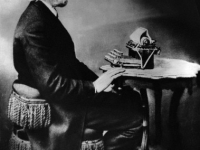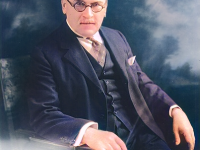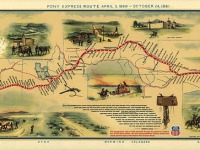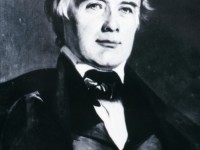
Elisha Gray (1835-1901)
On August 2, 1835, American electrical engineer Elisha Gray was born. Gray is best known for his development of a telephone prototype in 1876 and is considered by some to be the true inventor of the variable resistance telephone, despite losing out to Alexander Graham Bell for the telephone patent. But besides the telephone, Gray was a successful and prolific inventor. He is also considered to be the father of the modern music synthesizer, and was granted over 70 patents for his inventions.
Early Years of an Inventor
Elisha Gray was born into a Quaker family in Barnesville, Ohio, and was brought up on a farm. Gray was interested in making things from an early age. During his apprenticeship at a boat builder, Gray befriended Henry S. Bennett, a student at Oberlin College, who convinced Gray that he could work and get an education, too. Thus, Gray spent several years at Oberlin College where he experimented with electrical devices. Although Gray was not a graduate of Oberlin College, he taught electricity and science there. After his marriage with Delia Minerva Shepard, Gray began developing a string of inventions. In 1865, he invented a self-adjusting telegraph relay that automatically adapted to varying insulation of the telegraph line in 1865, for which he received a patent in 1867. Together with his partner Enos M. Barton he founded a company to supply telegraph equipment to the giant Western Union Telegraph Company. Gray’s inventions and patent costs were financed by a dentist, Dr. Samuel S. White of Philadelphia, who had made a fortune producing porcelain teeth. White wanted Gray to focus on the acoustic telegraph which promised huge profits to the exclusion of what appeared to be unpromising competing inventions such as the telephone. It was White’s decision in 1876 to abandon Gray’s patent application for the telephone.
To all whom it may concern: Be it known that I, Elisha Gray, of Chicago, in the County of Cook, and State of Illinois, have invented a new art of transmitting vocal sounds telegraphically, of which the following is a specification: It is the object of my invention to transmit the tones of the human voice through a telegraphic circuit, and reproduce them at the receiving end of the line, so that actual conversations can be carried on by persons at long distances apart. (Extract from Elisha Gray’s Patent Caveat Filed on February 14, 1876)
The Transmission of Voice
In 1874, Gray applied for a patent on a harmonic telegraph which consisted of multi-tone transmitters, each tone being controlled by a separate telegraph key. On December 29, 1874, Gray gave the first public demonstration of his ‘Musical Telegraph’ for transmitting musical tones and transmitted “familiar melodies through telegraph wire”. Because of Samuel White’s opposition to Gray working on the telephone, Gray did not tell anybody about his new invention for transmitting voice sounds until February 11, 1876 (Friday). On Monday morning February 14, 1876, Gray signed and had notarized the caveat that described a telephone that used a liquid microphone. Baldwin then submitted the caveat, i.e. a provisional patent application, to the US Patent Office. That same morning a lawyer for Alexander Graham Bell submitted Bell’s patent application. Which application arrived first is hotly disputed, although Gray believed that his caveat arrived a few hours before Bell’s application. On The other hand, Bell’s lawyers in Washington, DC, had been waiting with Bell’s patent application for months, under instructions not to file it in the USA until it had been filed in Britain first.
As to Bell’s talking telegraph, it only creates interest in scientific circles… its commercial values will be limited. (Elisha Gray)
Loosing the Patent Race
The attorneys, who arrived for Bell at the patent office, insisted that the intake clerk delivered their patent application immediately to the patent examination officer. Bell’s patent was recorded as the fifth patent received on Feb. 14, and Gray’s as the 39th. Consequently, Bell’s application became U.S. Patent No. 174,465 on March 7, 1876. On March 10, using the microphone design originally described by Gray, Alexander Graham Bell said the famous first transmitted words, “Mr. Watson — come here — I want to see you.” It was later discovered, however, that the apparatus described in Gray’s caveat would have worked, while that in Bell’s original patent would not have. After years of litigation, Bell was legally named the inventor of the telephone, although to many the question of who should be credited with the invention remained debatable. Gray’s loss in the race to lay claim to the invention of the telephone did not tarnish his professional reputation however. In 1880 he was named professor of dynamic electricity at Oberlin College in Ohio, where he taught with distinction. Elisha Gray died on January 21, 1901 in Newtonville, Massachusetts.
Elisha Gray: Oberlin Inventor and Electric Music Pioneer, [8]
References and Further Reading:
- [1] Elisha Gray and the Telephone
- [2] Elisha Gray at Britannica Online
- [3] Elisha Gray at Oberlin College
- [4] Works of Elisha Gray at Project Gutenberg
- [5] Johann Philipp Reis Demonstrates the first Telephone, SciHi Blog
- [6] Mary Had a Little Lamb – Edison and the Phonograph, SciHi Blog
- [7] Elisha Gray at Wikidata
- [8] Elisha Gray: Oberlin Inventor and Electric Music Pioneer, Oberlin Heritage Center @ youtube
- [9] Evenson, A. Edward (2000). The Telephone Patent Conspiracy of 1876: The Elisha Gray – Alexander Bell Controversy. North Carolina: McFarland.
- [10] Works by or about Elisha Gray at Internet Archive
- [11] Timeline for Discovery and Invention Controversies, via DBpedia and Wikidata






This comment has been removed by a blog administrator.
this doesn’t tell what he invented.